Auditing Theory and Practice: Analysis of Financial Statements Report
VerifiedAdded on 2020/04/01
|13
|2688
|426
Report
AI Summary
This report offers a detailed examination of auditing theory and practice, focusing on a comprehensive financial analysis. It begins with an executive summary that outlines the study's objectives, which include assessing various accounts, identifying audit risks, and suggesting risk reduction strategies. The report then delves into the critical assessment of different heads of accounts like receivables, investments, property, and intangible assets, highlighting associated risks and mitigation steps. Furthermore, the report analyzes key financial ratios such as return on equity, return on assets, and debt-equity ratio to evaluate the firm's financial health and potential risks. Internal control procedures are also thoroughly examined, with an emphasis on efficient control techniques and risk mitigation. The report also identifies weaknesses in the internal control system, providing a well-rounded perspective on auditing practices.
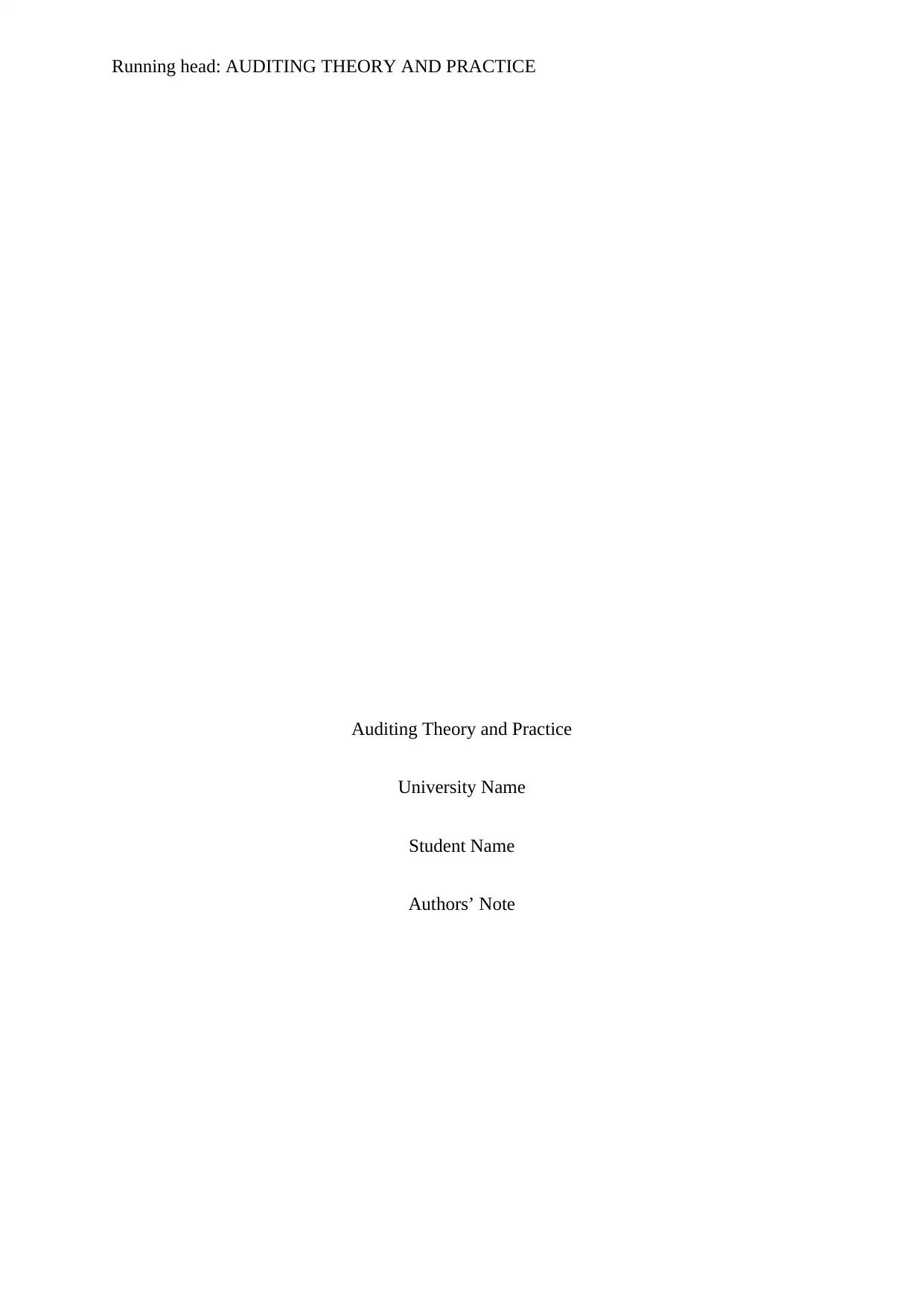
Running head: AUDITING THEORY AND PRACTICE
Auditing Theory and Practice
University Name
Student Name
Authors’ Note
Auditing Theory and Practice
University Name
Student Name
Authors’ Note
Paraphrase This Document
Need a fresh take? Get an instant paraphrase of this document with our AI Paraphraser
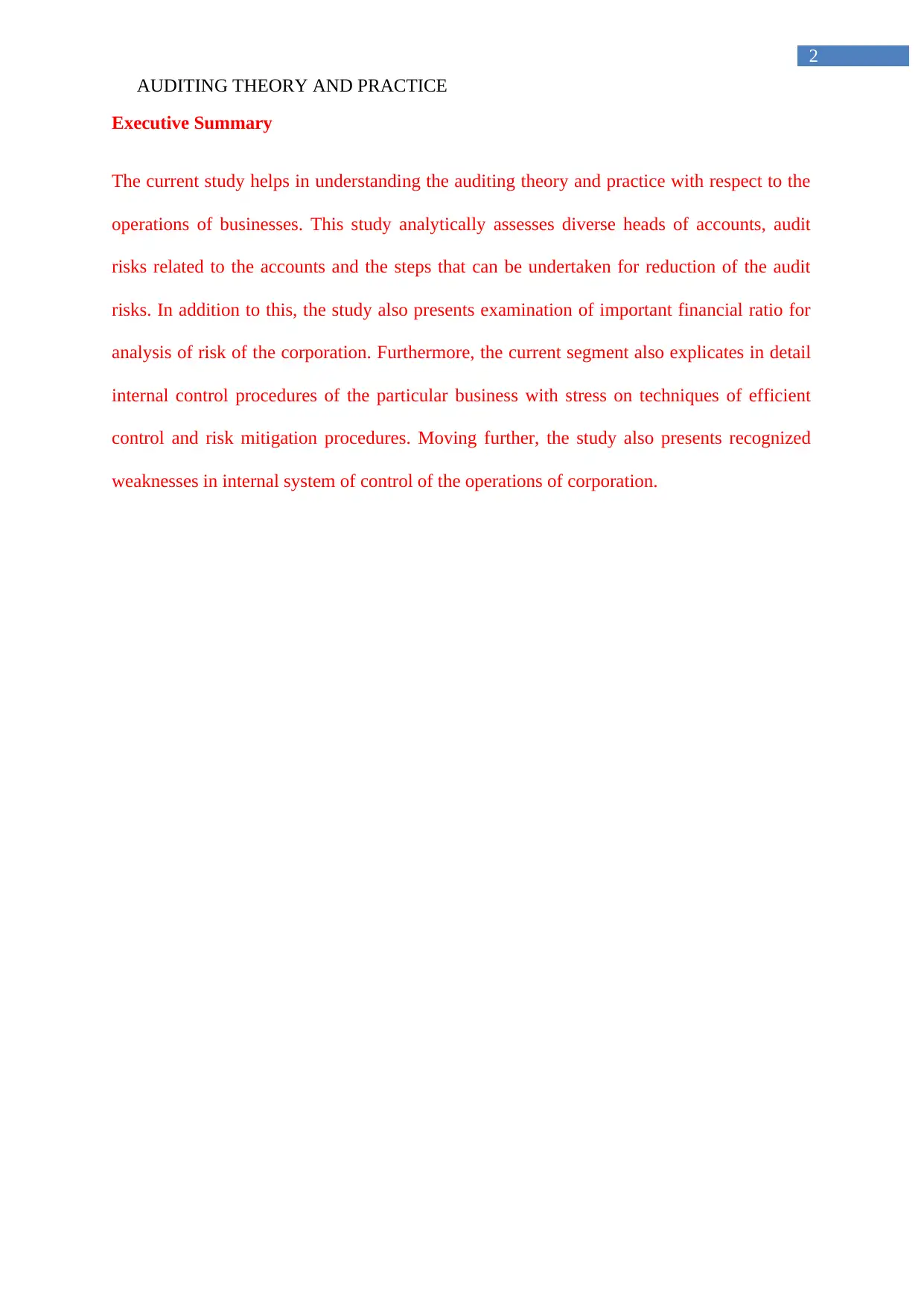
2
AUDITING THEORY AND PRACTICE
Executive Summary
The current study helps in understanding the auditing theory and practice with respect to the
operations of businesses. This study analytically assesses diverse heads of accounts, audit
risks related to the accounts and the steps that can be undertaken for reduction of the audit
risks. In addition to this, the study also presents examination of important financial ratio for
analysis of risk of the corporation. Furthermore, the current segment also explicates in detail
internal control procedures of the particular business with stress on techniques of efficient
control and risk mitigation procedures. Moving further, the study also presents recognized
weaknesses in internal system of control of the operations of corporation.
AUDITING THEORY AND PRACTICE
Executive Summary
The current study helps in understanding the auditing theory and practice with respect to the
operations of businesses. This study analytically assesses diverse heads of accounts, audit
risks related to the accounts and the steps that can be undertaken for reduction of the audit
risks. In addition to this, the study also presents examination of important financial ratio for
analysis of risk of the corporation. Furthermore, the current segment also explicates in detail
internal control procedures of the particular business with stress on techniques of efficient
control and risk mitigation procedures. Moving further, the study also presents recognized
weaknesses in internal system of control of the operations of corporation.
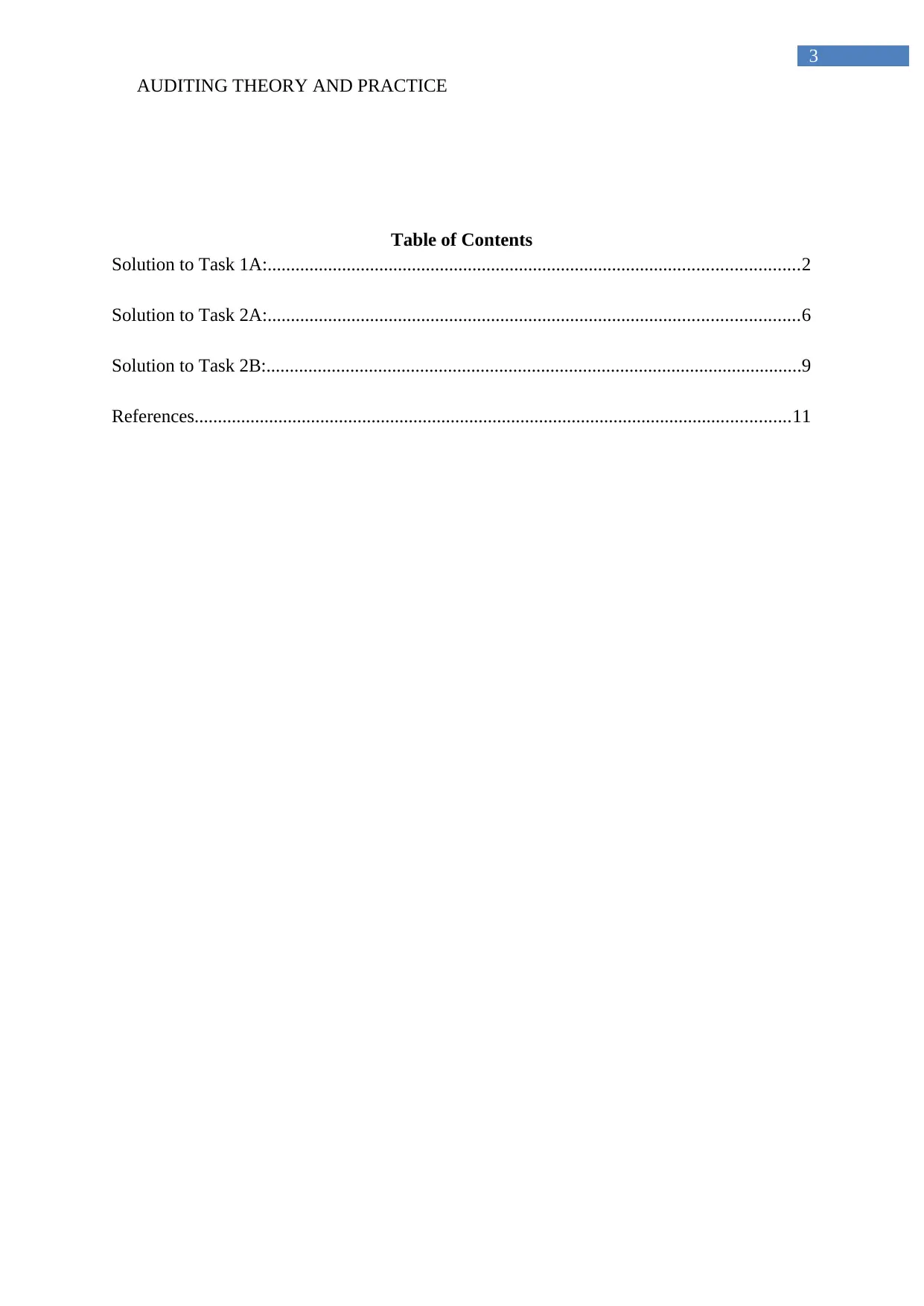
3
AUDITING THEORY AND PRACTICE
Table of Contents
Solution to Task 1A:..................................................................................................................2
Solution to Task 2A:..................................................................................................................6
Solution to Task 2B:...................................................................................................................9
References................................................................................................................................11
AUDITING THEORY AND PRACTICE
Table of Contents
Solution to Task 1A:..................................................................................................................2
Solution to Task 2A:..................................................................................................................6
Solution to Task 2B:...................................................................................................................9
References................................................................................................................................11
⊘ This is a preview!⊘
Do you want full access?
Subscribe today to unlock all pages.

Trusted by 1+ million students worldwide
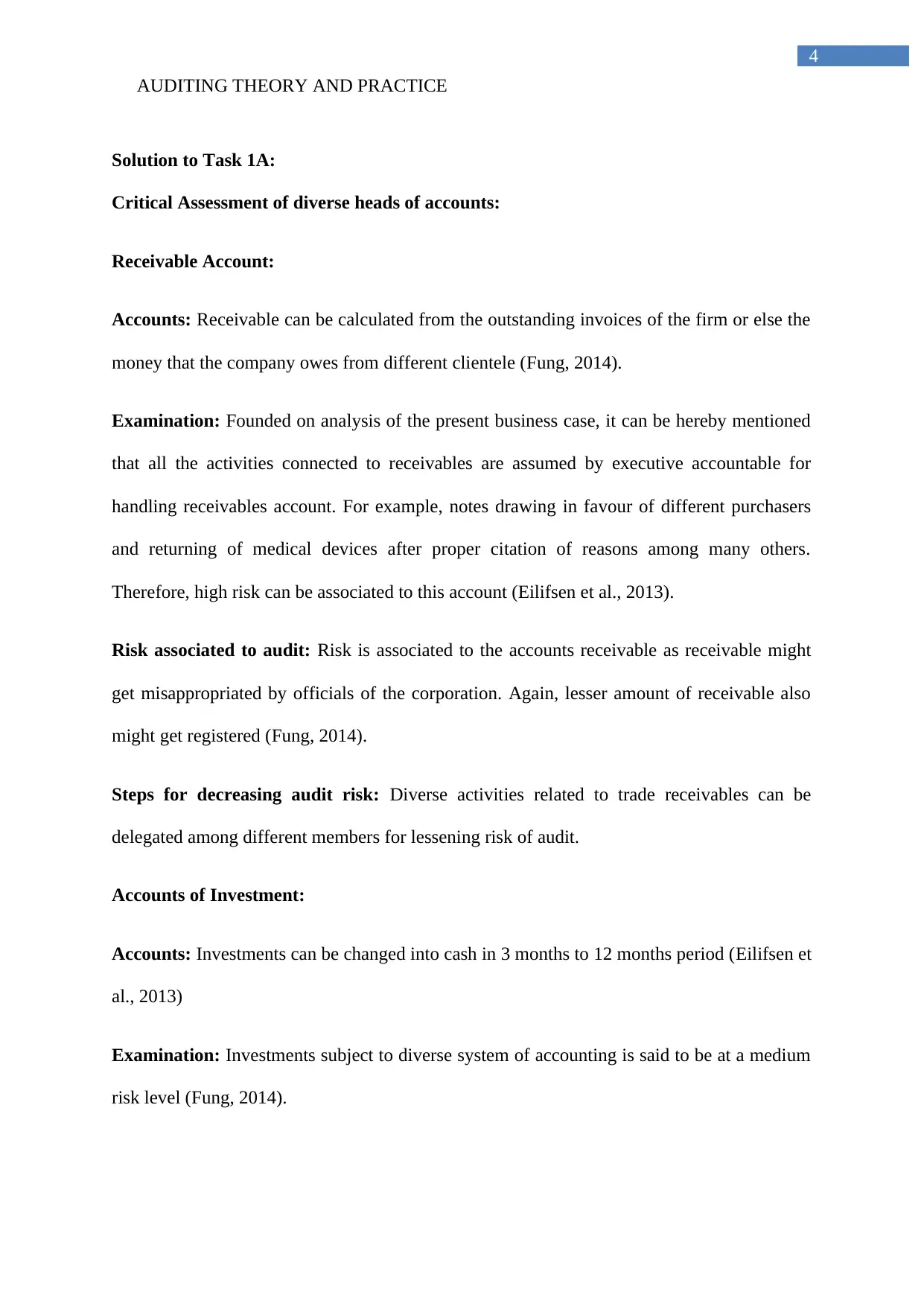
4
AUDITING THEORY AND PRACTICE
Solution to Task 1A:
Critical Assessment of diverse heads of accounts:
Receivable Account:
Accounts: Receivable can be calculated from the outstanding invoices of the firm or else the
money that the company owes from different clientele (Fung, 2014).
Examination: Founded on analysis of the present business case, it can be hereby mentioned
that all the activities connected to receivables are assumed by executive accountable for
handling receivables account. For example, notes drawing in favour of different purchasers
and returning of medical devices after proper citation of reasons among many others.
Therefore, high risk can be associated to this account (Eilifsen et al., 2013).
Risk associated to audit: Risk is associated to the accounts receivable as receivable might
get misappropriated by officials of the corporation. Again, lesser amount of receivable also
might get registered (Fung, 2014).
Steps for decreasing audit risk: Diverse activities related to trade receivables can be
delegated among different members for lessening risk of audit.
Accounts of Investment:
Accounts: Investments can be changed into cash in 3 months to 12 months period (Eilifsen et
al., 2013)
Examination: Investments subject to diverse system of accounting is said to be at a medium
risk level (Fung, 2014).
AUDITING THEORY AND PRACTICE
Solution to Task 1A:
Critical Assessment of diverse heads of accounts:
Receivable Account:
Accounts: Receivable can be calculated from the outstanding invoices of the firm or else the
money that the company owes from different clientele (Fung, 2014).
Examination: Founded on analysis of the present business case, it can be hereby mentioned
that all the activities connected to receivables are assumed by executive accountable for
handling receivables account. For example, notes drawing in favour of different purchasers
and returning of medical devices after proper citation of reasons among many others.
Therefore, high risk can be associated to this account (Eilifsen et al., 2013).
Risk associated to audit: Risk is associated to the accounts receivable as receivable might
get misappropriated by officials of the corporation. Again, lesser amount of receivable also
might get registered (Fung, 2014).
Steps for decreasing audit risk: Diverse activities related to trade receivables can be
delegated among different members for lessening risk of audit.
Accounts of Investment:
Accounts: Investments can be changed into cash in 3 months to 12 months period (Eilifsen et
al., 2013)
Examination: Investments subject to diverse system of accounting is said to be at a medium
risk level (Fung, 2014).
Paraphrase This Document
Need a fresh take? Get an instant paraphrase of this document with our AI Paraphraser
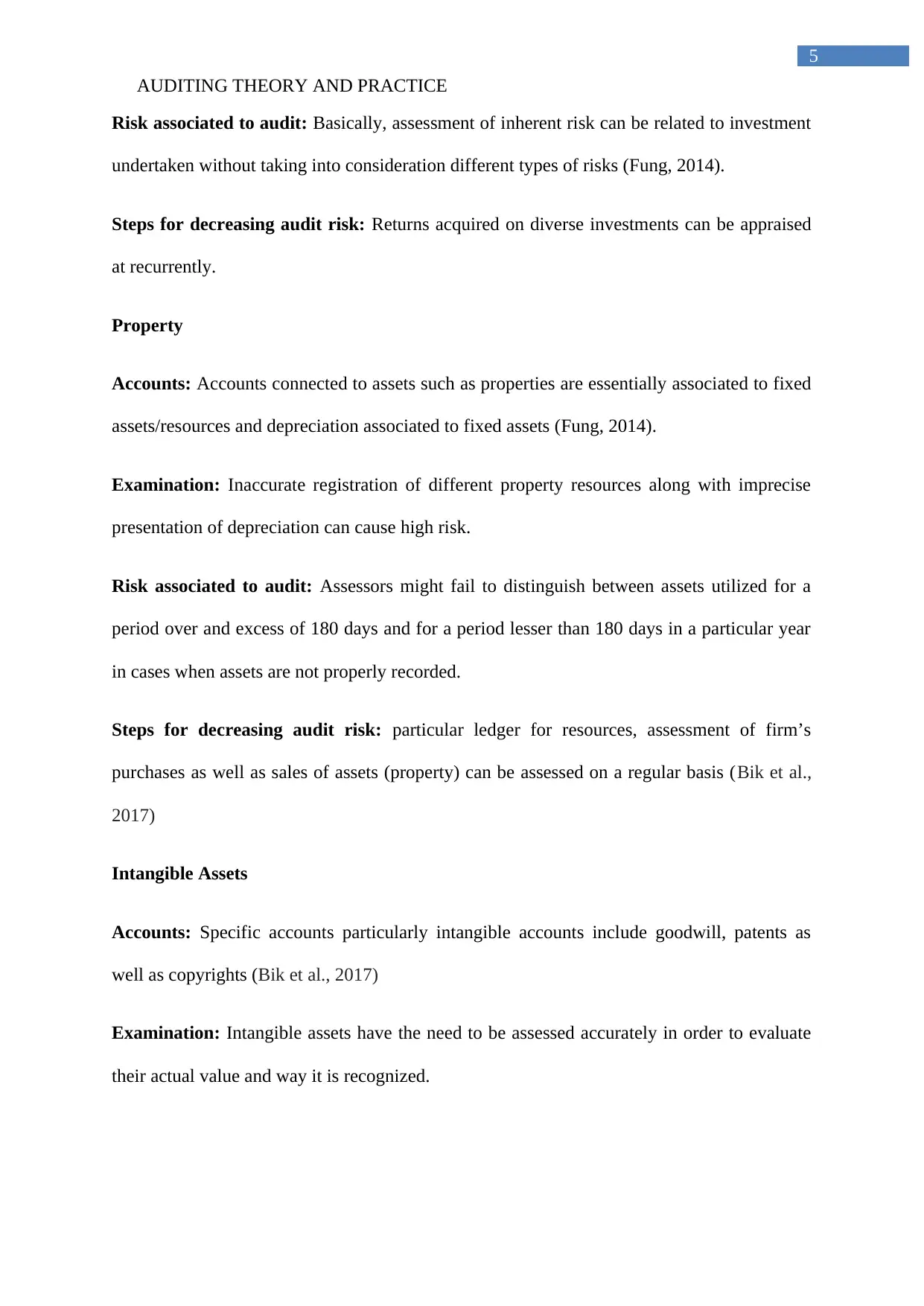
5
AUDITING THEORY AND PRACTICE
Risk associated to audit: Basically, assessment of inherent risk can be related to investment
undertaken without taking into consideration different types of risks (Fung, 2014).
Steps for decreasing audit risk: Returns acquired on diverse investments can be appraised
at recurrently.
Property
Accounts: Accounts connected to assets such as properties are essentially associated to fixed
assets/resources and depreciation associated to fixed assets (Fung, 2014).
Examination: Inaccurate registration of different property resources along with imprecise
presentation of depreciation can cause high risk.
Risk associated to audit: Assessors might fail to distinguish between assets utilized for a
period over and excess of 180 days and for a period lesser than 180 days in a particular year
in cases when assets are not properly recorded.
Steps for decreasing audit risk: particular ledger for resources, assessment of firm’s
purchases as well as sales of assets (property) can be assessed on a regular basis (Bik et al.,
2017)
Intangible Assets
Accounts: Specific accounts particularly intangible accounts include goodwill, patents as
well as copyrights (Bik et al., 2017)
Examination: Intangible assets have the need to be assessed accurately in order to evaluate
their actual value and way it is recognized.
AUDITING THEORY AND PRACTICE
Risk associated to audit: Basically, assessment of inherent risk can be related to investment
undertaken without taking into consideration different types of risks (Fung, 2014).
Steps for decreasing audit risk: Returns acquired on diverse investments can be appraised
at recurrently.
Property
Accounts: Accounts connected to assets such as properties are essentially associated to fixed
assets/resources and depreciation associated to fixed assets (Fung, 2014).
Examination: Inaccurate registration of different property resources along with imprecise
presentation of depreciation can cause high risk.
Risk associated to audit: Assessors might fail to distinguish between assets utilized for a
period over and excess of 180 days and for a period lesser than 180 days in a particular year
in cases when assets are not properly recorded.
Steps for decreasing audit risk: particular ledger for resources, assessment of firm’s
purchases as well as sales of assets (property) can be assessed on a regular basis (Bik et al.,
2017)
Intangible Assets
Accounts: Specific accounts particularly intangible accounts include goodwill, patents as
well as copyrights (Bik et al., 2017)
Examination: Intangible assets have the need to be assessed accurately in order to evaluate
their actual value and way it is recognized.
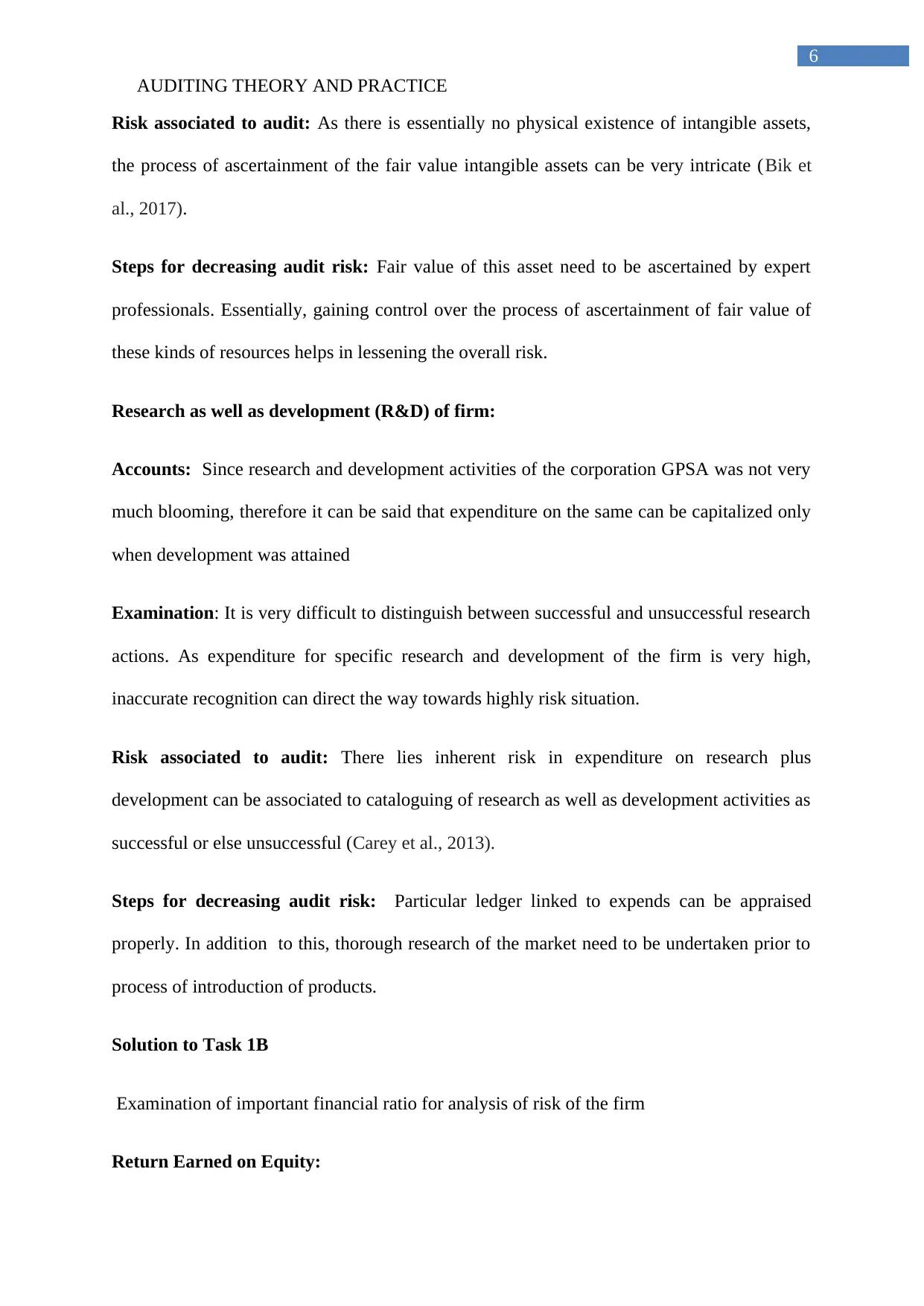
6
AUDITING THEORY AND PRACTICE
Risk associated to audit: As there is essentially no physical existence of intangible assets,
the process of ascertainment of the fair value intangible assets can be very intricate (Bik et
al., 2017).
Steps for decreasing audit risk: Fair value of this asset need to be ascertained by expert
professionals. Essentially, gaining control over the process of ascertainment of fair value of
these kinds of resources helps in lessening the overall risk.
Research as well as development (R&D) of firm:
Accounts: Since research and development activities of the corporation GPSA was not very
much blooming, therefore it can be said that expenditure on the same can be capitalized only
when development was attained
Examination: It is very difficult to distinguish between successful and unsuccessful research
actions. As expenditure for specific research and development of the firm is very high,
inaccurate recognition can direct the way towards highly risk situation.
Risk associated to audit: There lies inherent risk in expenditure on research plus
development can be associated to cataloguing of research as well as development activities as
successful or else unsuccessful (Carey et al., 2013).
Steps for decreasing audit risk: Particular ledger linked to expends can be appraised
properly. In addition to this, thorough research of the market need to be undertaken prior to
process of introduction of products.
Solution to Task 1B
Examination of important financial ratio for analysis of risk of the firm
Return Earned on Equity:
AUDITING THEORY AND PRACTICE
Risk associated to audit: As there is essentially no physical existence of intangible assets,
the process of ascertainment of the fair value intangible assets can be very intricate (Bik et
al., 2017).
Steps for decreasing audit risk: Fair value of this asset need to be ascertained by expert
professionals. Essentially, gaining control over the process of ascertainment of fair value of
these kinds of resources helps in lessening the overall risk.
Research as well as development (R&D) of firm:
Accounts: Since research and development activities of the corporation GPSA was not very
much blooming, therefore it can be said that expenditure on the same can be capitalized only
when development was attained
Examination: It is very difficult to distinguish between successful and unsuccessful research
actions. As expenditure for specific research and development of the firm is very high,
inaccurate recognition can direct the way towards highly risk situation.
Risk associated to audit: There lies inherent risk in expenditure on research plus
development can be associated to cataloguing of research as well as development activities as
successful or else unsuccessful (Carey et al., 2013).
Steps for decreasing audit risk: Particular ledger linked to expends can be appraised
properly. In addition to this, thorough research of the market need to be undertaken prior to
process of introduction of products.
Solution to Task 1B
Examination of important financial ratio for analysis of risk of the firm
Return Earned on Equity:
⊘ This is a preview!⊘
Do you want full access?
Subscribe today to unlock all pages.

Trusted by 1+ million students worldwide
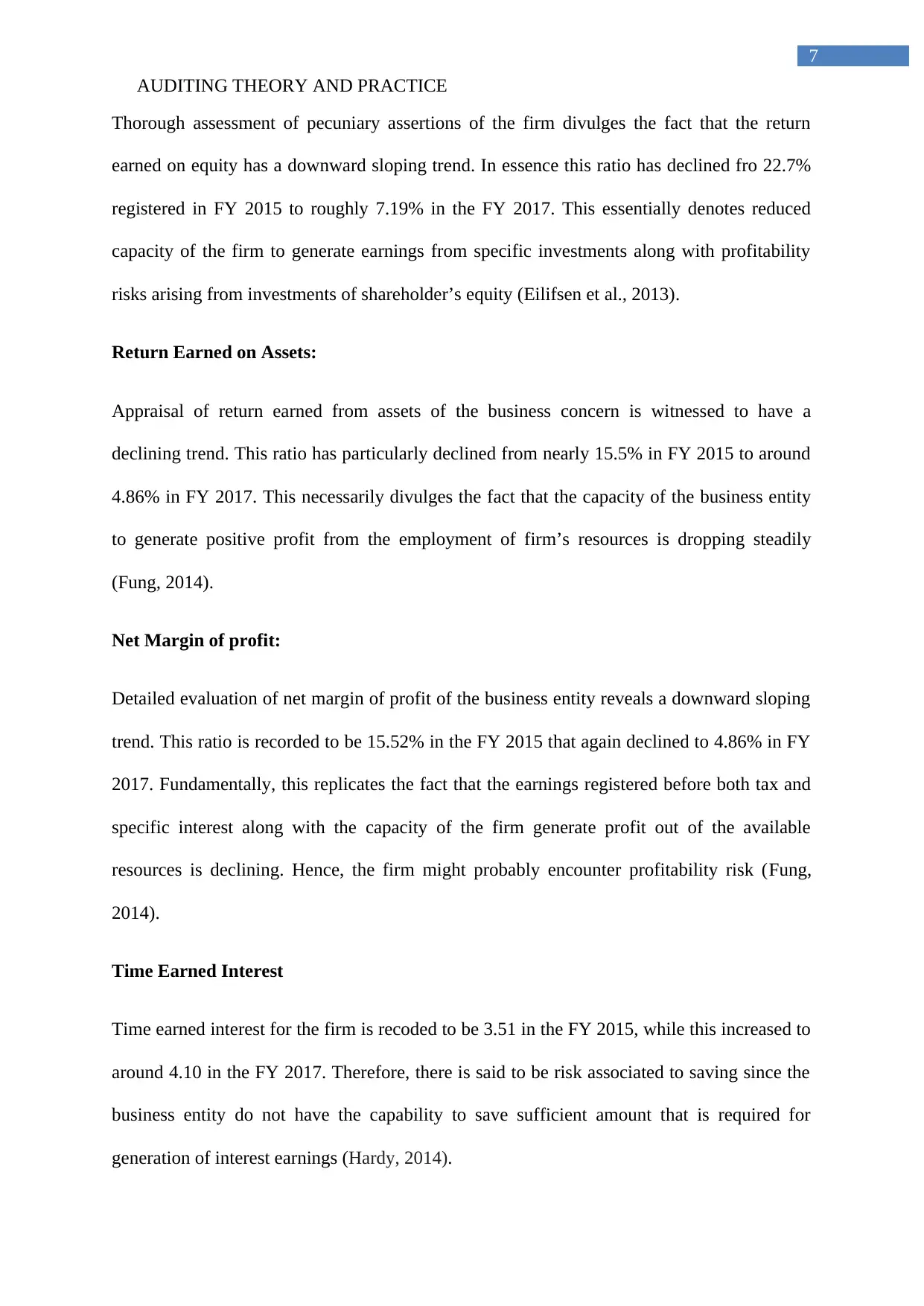
7
AUDITING THEORY AND PRACTICE
Thorough assessment of pecuniary assertions of the firm divulges the fact that the return
earned on equity has a downward sloping trend. In essence this ratio has declined fro 22.7%
registered in FY 2015 to roughly 7.19% in the FY 2017. This essentially denotes reduced
capacity of the firm to generate earnings from specific investments along with profitability
risks arising from investments of shareholder’s equity (Eilifsen et al., 2013).
Return Earned on Assets:
Appraisal of return earned from assets of the business concern is witnessed to have a
declining trend. This ratio has particularly declined from nearly 15.5% in FY 2015 to around
4.86% in FY 2017. This necessarily divulges the fact that the capacity of the business entity
to generate positive profit from the employment of firm’s resources is dropping steadily
(Fung, 2014).
Net Margin of profit:
Detailed evaluation of net margin of profit of the business entity reveals a downward sloping
trend. This ratio is recorded to be 15.52% in the FY 2015 that again declined to 4.86% in FY
2017. Fundamentally, this replicates the fact that the earnings registered before both tax and
specific interest along with the capacity of the firm generate profit out of the available
resources is declining. Hence, the firm might probably encounter profitability risk (Fung,
2014).
Time Earned Interest
Time earned interest for the firm is recoded to be 3.51 in the FY 2015, while this increased to
around 4.10 in the FY 2017. Therefore, there is said to be risk associated to saving since the
business entity do not have the capability to save sufficient amount that is required for
generation of interest earnings (Hardy, 2014).
AUDITING THEORY AND PRACTICE
Thorough assessment of pecuniary assertions of the firm divulges the fact that the return
earned on equity has a downward sloping trend. In essence this ratio has declined fro 22.7%
registered in FY 2015 to roughly 7.19% in the FY 2017. This essentially denotes reduced
capacity of the firm to generate earnings from specific investments along with profitability
risks arising from investments of shareholder’s equity (Eilifsen et al., 2013).
Return Earned on Assets:
Appraisal of return earned from assets of the business concern is witnessed to have a
declining trend. This ratio has particularly declined from nearly 15.5% in FY 2015 to around
4.86% in FY 2017. This necessarily divulges the fact that the capacity of the business entity
to generate positive profit from the employment of firm’s resources is dropping steadily
(Fung, 2014).
Net Margin of profit:
Detailed evaluation of net margin of profit of the business entity reveals a downward sloping
trend. This ratio is recorded to be 15.52% in the FY 2015 that again declined to 4.86% in FY
2017. Fundamentally, this replicates the fact that the earnings registered before both tax and
specific interest along with the capacity of the firm generate profit out of the available
resources is declining. Hence, the firm might probably encounter profitability risk (Fung,
2014).
Time Earned Interest
Time earned interest for the firm is recoded to be 3.51 in the FY 2015, while this increased to
around 4.10 in the FY 2017. Therefore, there is said to be risk associated to saving since the
business entity do not have the capability to save sufficient amount that is required for
generation of interest earnings (Hardy, 2014).
Paraphrase This Document
Need a fresh take? Get an instant paraphrase of this document with our AI Paraphraser
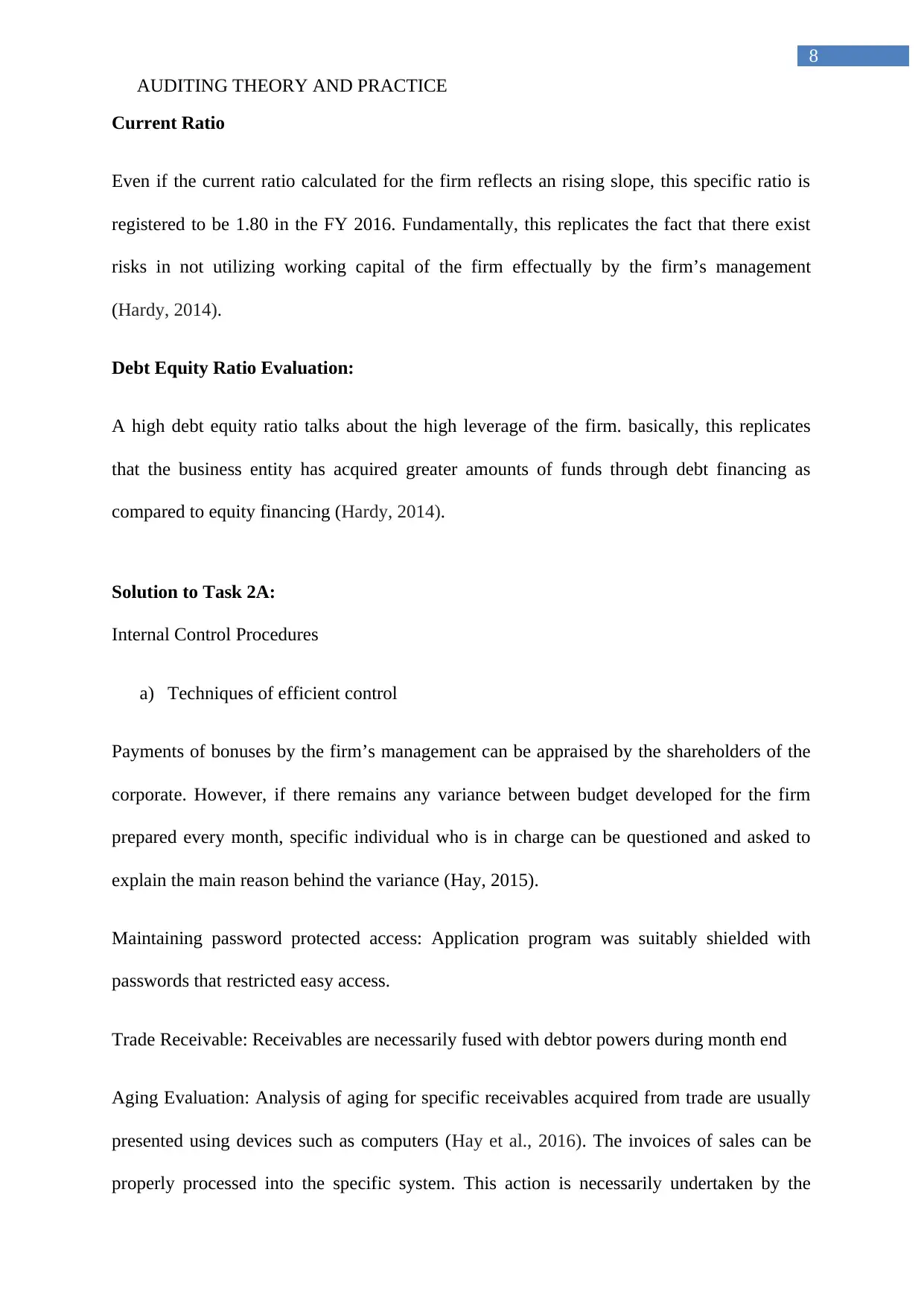
8
AUDITING THEORY AND PRACTICE
Current Ratio
Even if the current ratio calculated for the firm reflects an rising slope, this specific ratio is
registered to be 1.80 in the FY 2016. Fundamentally, this replicates the fact that there exist
risks in not utilizing working capital of the firm effectually by the firm’s management
(Hardy, 2014).
Debt Equity Ratio Evaluation:
A high debt equity ratio talks about the high leverage of the firm. basically, this replicates
that the business entity has acquired greater amounts of funds through debt financing as
compared to equity financing (Hardy, 2014).
Solution to Task 2A:
Internal Control Procedures
a) Techniques of efficient control
Payments of bonuses by the firm’s management can be appraised by the shareholders of the
corporate. However, if there remains any variance between budget developed for the firm
prepared every month, specific individual who is in charge can be questioned and asked to
explain the main reason behind the variance (Hay, 2015).
Maintaining password protected access: Application program was suitably shielded with
passwords that restricted easy access.
Trade Receivable: Receivables are necessarily fused with debtor powers during month end
Aging Evaluation: Analysis of aging for specific receivables acquired from trade are usually
presented using devices such as computers (Hay et al., 2016). The invoices of sales can be
properly processed into the specific system. This action is necessarily undertaken by the
AUDITING THEORY AND PRACTICE
Current Ratio
Even if the current ratio calculated for the firm reflects an rising slope, this specific ratio is
registered to be 1.80 in the FY 2016. Fundamentally, this replicates the fact that there exist
risks in not utilizing working capital of the firm effectually by the firm’s management
(Hardy, 2014).
Debt Equity Ratio Evaluation:
A high debt equity ratio talks about the high leverage of the firm. basically, this replicates
that the business entity has acquired greater amounts of funds through debt financing as
compared to equity financing (Hardy, 2014).
Solution to Task 2A:
Internal Control Procedures
a) Techniques of efficient control
Payments of bonuses by the firm’s management can be appraised by the shareholders of the
corporate. However, if there remains any variance between budget developed for the firm
prepared every month, specific individual who is in charge can be questioned and asked to
explain the main reason behind the variance (Hay, 2015).
Maintaining password protected access: Application program was suitably shielded with
passwords that restricted easy access.
Trade Receivable: Receivables are necessarily fused with debtor powers during month end
Aging Evaluation: Analysis of aging for specific receivables acquired from trade are usually
presented using devices such as computers (Hay et al., 2016). The invoices of sales can be
properly processed into the specific system. This action is necessarily undertaken by the
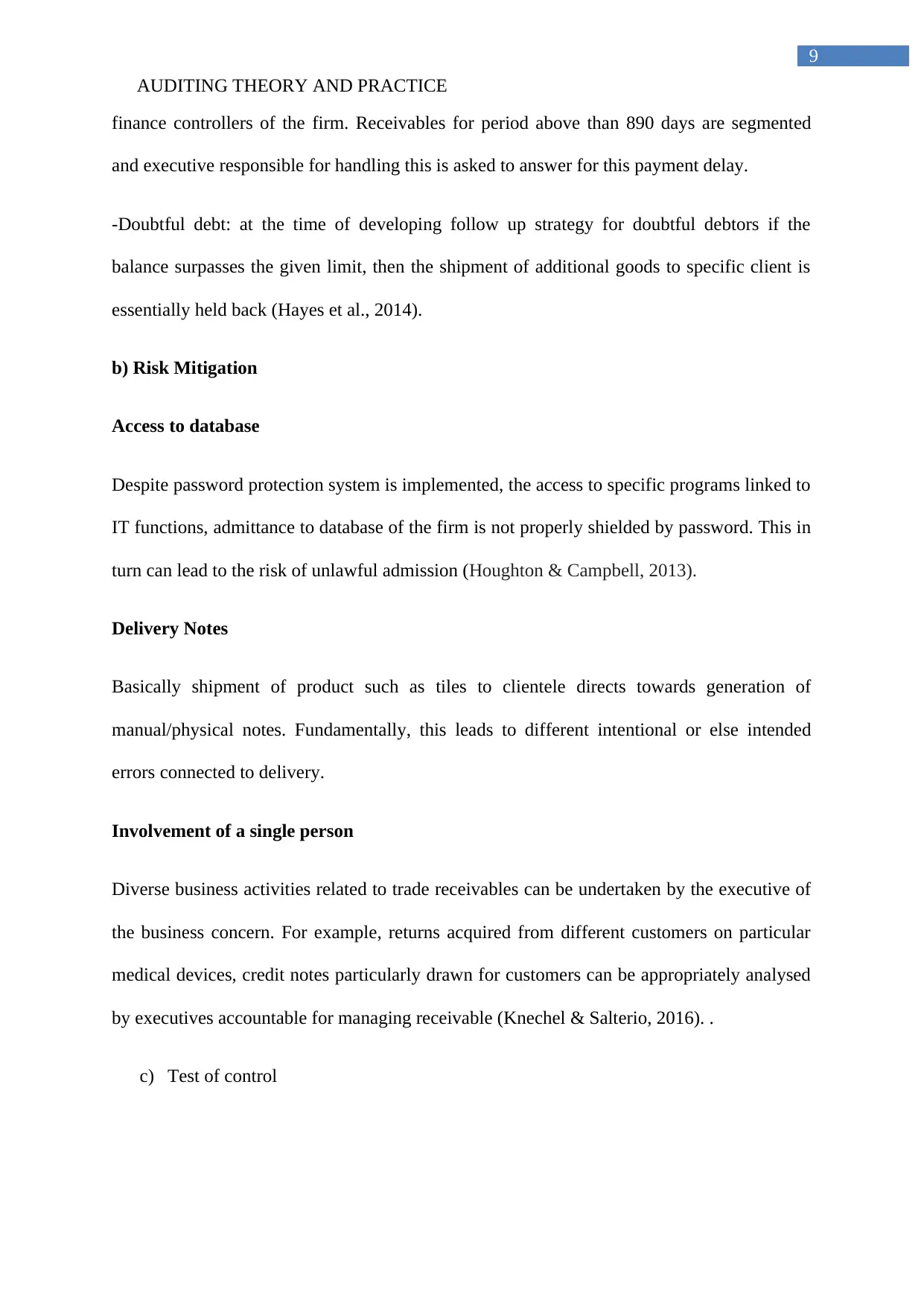
9
AUDITING THEORY AND PRACTICE
finance controllers of the firm. Receivables for period above than 890 days are segmented
and executive responsible for handling this is asked to answer for this payment delay.
-Doubtful debt: at the time of developing follow up strategy for doubtful debtors if the
balance surpasses the given limit, then the shipment of additional goods to specific client is
essentially held back (Hayes et al., 2014).
b) Risk Mitigation
Access to database
Despite password protection system is implemented, the access to specific programs linked to
IT functions, admittance to database of the firm is not properly shielded by password. This in
turn can lead to the risk of unlawful admission (Houghton & Campbell, 2013).
Delivery Notes
Basically shipment of product such as tiles to clientele directs towards generation of
manual/physical notes. Fundamentally, this leads to different intentional or else intended
errors connected to delivery.
Involvement of a single person
Diverse business activities related to trade receivables can be undertaken by the executive of
the business concern. For example, returns acquired from different customers on particular
medical devices, credit notes particularly drawn for customers can be appropriately analysed
by executives accountable for managing receivable (Knechel & Salterio, 2016). .
c) Test of control
AUDITING THEORY AND PRACTICE
finance controllers of the firm. Receivables for period above than 890 days are segmented
and executive responsible for handling this is asked to answer for this payment delay.
-Doubtful debt: at the time of developing follow up strategy for doubtful debtors if the
balance surpasses the given limit, then the shipment of additional goods to specific client is
essentially held back (Hayes et al., 2014).
b) Risk Mitigation
Access to database
Despite password protection system is implemented, the access to specific programs linked to
IT functions, admittance to database of the firm is not properly shielded by password. This in
turn can lead to the risk of unlawful admission (Houghton & Campbell, 2013).
Delivery Notes
Basically shipment of product such as tiles to clientele directs towards generation of
manual/physical notes. Fundamentally, this leads to different intentional or else intended
errors connected to delivery.
Involvement of a single person
Diverse business activities related to trade receivables can be undertaken by the executive of
the business concern. For example, returns acquired from different customers on particular
medical devices, credit notes particularly drawn for customers can be appropriately analysed
by executives accountable for managing receivable (Knechel & Salterio, 2016). .
c) Test of control
⊘ This is a preview!⊘
Do you want full access?
Subscribe today to unlock all pages.

Trusted by 1+ million students worldwide
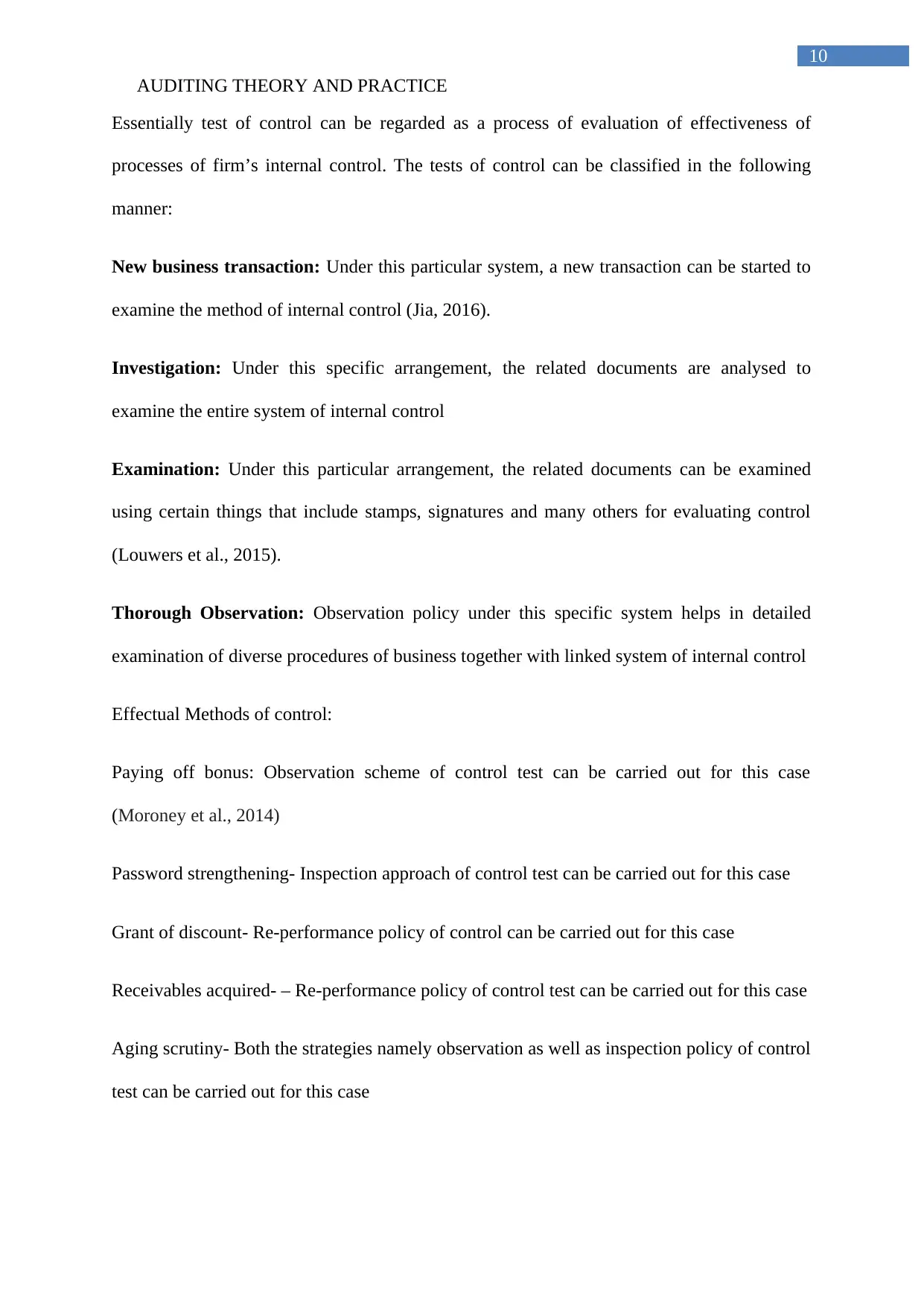
10
AUDITING THEORY AND PRACTICE
Essentially test of control can be regarded as a process of evaluation of effectiveness of
processes of firm’s internal control. The tests of control can be classified in the following
manner:
New business transaction: Under this particular system, a new transaction can be started to
examine the method of internal control (Jia, 2016).
Investigation: Under this specific arrangement, the related documents are analysed to
examine the entire system of internal control
Examination: Under this particular arrangement, the related documents can be examined
using certain things that include stamps, signatures and many others for evaluating control
(Louwers et al., 2015).
Thorough Observation: Observation policy under this specific system helps in detailed
examination of diverse procedures of business together with linked system of internal control
Effectual Methods of control:
Paying off bonus: Observation scheme of control test can be carried out for this case
(Moroney et al., 2014)
Password strengthening- Inspection approach of control test can be carried out for this case
Grant of discount- Re-performance policy of control can be carried out for this case
Receivables acquired- – Re-performance policy of control test can be carried out for this case
Aging scrutiny- Both the strategies namely observation as well as inspection policy of control
test can be carried out for this case
AUDITING THEORY AND PRACTICE
Essentially test of control can be regarded as a process of evaluation of effectiveness of
processes of firm’s internal control. The tests of control can be classified in the following
manner:
New business transaction: Under this particular system, a new transaction can be started to
examine the method of internal control (Jia, 2016).
Investigation: Under this specific arrangement, the related documents are analysed to
examine the entire system of internal control
Examination: Under this particular arrangement, the related documents can be examined
using certain things that include stamps, signatures and many others for evaluating control
(Louwers et al., 2015).
Thorough Observation: Observation policy under this specific system helps in detailed
examination of diverse procedures of business together with linked system of internal control
Effectual Methods of control:
Paying off bonus: Observation scheme of control test can be carried out for this case
(Moroney et al., 2014)
Password strengthening- Inspection approach of control test can be carried out for this case
Grant of discount- Re-performance policy of control can be carried out for this case
Receivables acquired- – Re-performance policy of control test can be carried out for this case
Aging scrutiny- Both the strategies namely observation as well as inspection policy of control
test can be carried out for this case
Paraphrase This Document
Need a fresh take? Get an instant paraphrase of this document with our AI Paraphraser
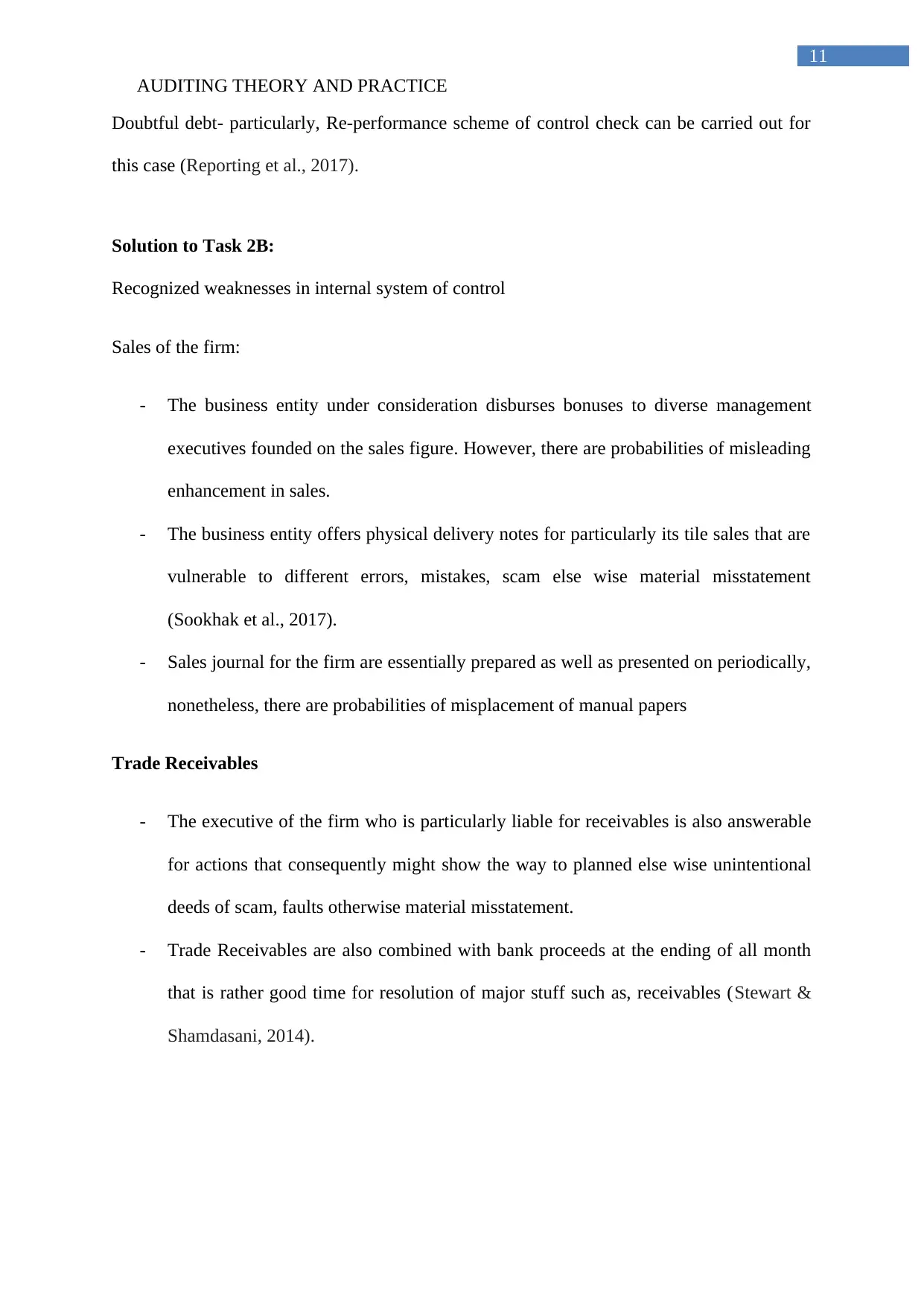
11
AUDITING THEORY AND PRACTICE
Doubtful debt- particularly, Re-performance scheme of control check can be carried out for
this case (Reporting et al., 2017).
Solution to Task 2B:
Recognized weaknesses in internal system of control
Sales of the firm:
- The business entity under consideration disburses bonuses to diverse management
executives founded on the sales figure. However, there are probabilities of misleading
enhancement in sales.
- The business entity offers physical delivery notes for particularly its tile sales that are
vulnerable to different errors, mistakes, scam else wise material misstatement
(Sookhak et al., 2017).
- Sales journal for the firm are essentially prepared as well as presented on periodically,
nonetheless, there are probabilities of misplacement of manual papers
Trade Receivables
- The executive of the firm who is particularly liable for receivables is also answerable
for actions that consequently might show the way to planned else wise unintentional
deeds of scam, faults otherwise material misstatement.
- Trade Receivables are also combined with bank proceeds at the ending of all month
that is rather good time for resolution of major stuff such as, receivables (Stewart &
Shamdasani, 2014).
AUDITING THEORY AND PRACTICE
Doubtful debt- particularly, Re-performance scheme of control check can be carried out for
this case (Reporting et al., 2017).
Solution to Task 2B:
Recognized weaknesses in internal system of control
Sales of the firm:
- The business entity under consideration disburses bonuses to diverse management
executives founded on the sales figure. However, there are probabilities of misleading
enhancement in sales.
- The business entity offers physical delivery notes for particularly its tile sales that are
vulnerable to different errors, mistakes, scam else wise material misstatement
(Sookhak et al., 2017).
- Sales journal for the firm are essentially prepared as well as presented on periodically,
nonetheless, there are probabilities of misplacement of manual papers
Trade Receivables
- The executive of the firm who is particularly liable for receivables is also answerable
for actions that consequently might show the way to planned else wise unintentional
deeds of scam, faults otherwise material misstatement.
- Trade Receivables are also combined with bank proceeds at the ending of all month
that is rather good time for resolution of major stuff such as, receivables (Stewart &
Shamdasani, 2014).
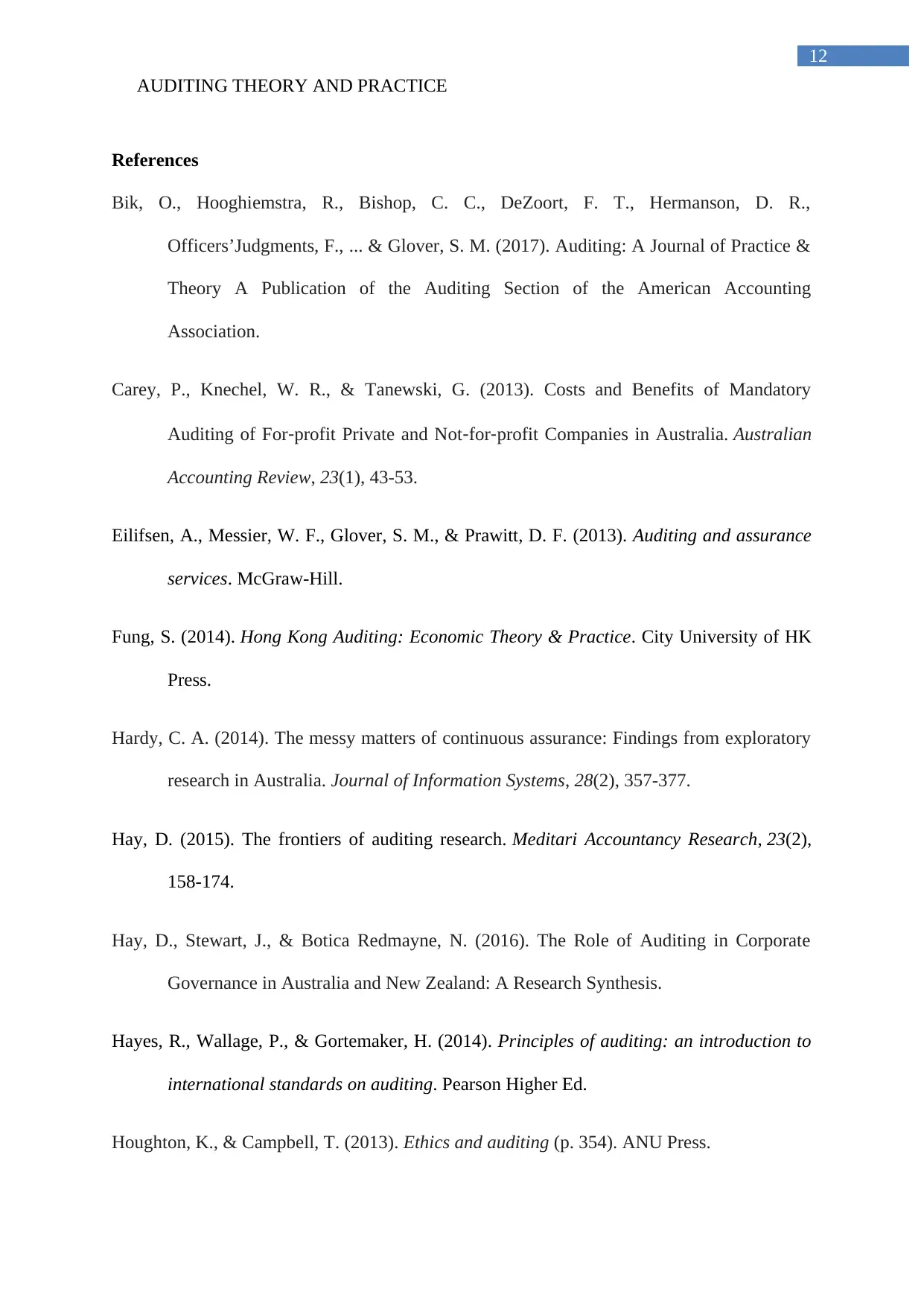
12
AUDITING THEORY AND PRACTICE
References
Bik, O., Hooghiemstra, R., Bishop, C. C., DeZoort, F. T., Hermanson, D. R.,
Officers’Judgments, F., ... & Glover, S. M. (2017). Auditing: A Journal of Practice &
Theory A Publication of the Auditing Section of the American Accounting
Association.
Carey, P., Knechel, W. R., & Tanewski, G. (2013). Costs and Benefits of Mandatory
Auditing of For‐profit Private and Not‐for‐profit Companies in Australia. Australian
Accounting Review, 23(1), 43-53.
Eilifsen, A., Messier, W. F., Glover, S. M., & Prawitt, D. F. (2013). Auditing and assurance
services. McGraw-Hill.
Fung, S. (2014). Hong Kong Auditing: Economic Theory & Practice. City University of HK
Press.
Hardy, C. A. (2014). The messy matters of continuous assurance: Findings from exploratory
research in Australia. Journal of Information Systems, 28(2), 357-377.
Hay, D. (2015). The frontiers of auditing research. Meditari Accountancy Research, 23(2),
158-174.
Hay, D., Stewart, J., & Botica Redmayne, N. (2016). The Role of Auditing in Corporate
Governance in Australia and New Zealand: A Research Synthesis.
Hayes, R., Wallage, P., & Gortemaker, H. (2014). Principles of auditing: an introduction to
international standards on auditing. Pearson Higher Ed.
Houghton, K., & Campbell, T. (2013). Ethics and auditing (p. 354). ANU Press.
AUDITING THEORY AND PRACTICE
References
Bik, O., Hooghiemstra, R., Bishop, C. C., DeZoort, F. T., Hermanson, D. R.,
Officers’Judgments, F., ... & Glover, S. M. (2017). Auditing: A Journal of Practice &
Theory A Publication of the Auditing Section of the American Accounting
Association.
Carey, P., Knechel, W. R., & Tanewski, G. (2013). Costs and Benefits of Mandatory
Auditing of For‐profit Private and Not‐for‐profit Companies in Australia. Australian
Accounting Review, 23(1), 43-53.
Eilifsen, A., Messier, W. F., Glover, S. M., & Prawitt, D. F. (2013). Auditing and assurance
services. McGraw-Hill.
Fung, S. (2014). Hong Kong Auditing: Economic Theory & Practice. City University of HK
Press.
Hardy, C. A. (2014). The messy matters of continuous assurance: Findings from exploratory
research in Australia. Journal of Information Systems, 28(2), 357-377.
Hay, D. (2015). The frontiers of auditing research. Meditari Accountancy Research, 23(2),
158-174.
Hay, D., Stewart, J., & Botica Redmayne, N. (2016). The Role of Auditing in Corporate
Governance in Australia and New Zealand: A Research Synthesis.
Hayes, R., Wallage, P., & Gortemaker, H. (2014). Principles of auditing: an introduction to
international standards on auditing. Pearson Higher Ed.
Houghton, K., & Campbell, T. (2013). Ethics and auditing (p. 354). ANU Press.
⊘ This is a preview!⊘
Do you want full access?
Subscribe today to unlock all pages.

Trusted by 1+ million students worldwide
1 out of 13
Related Documents
Your All-in-One AI-Powered Toolkit for Academic Success.
+13062052269
info@desklib.com
Available 24*7 on WhatsApp / Email
![[object Object]](/_next/static/media/star-bottom.7253800d.svg)
Unlock your academic potential
Copyright © 2020–2025 A2Z Services. All Rights Reserved. Developed and managed by ZUCOL.




